Brief

"Nothing is stronger than an idea whose time has come”1 — Victor Hugo, 1877
There are too few women in top leadership positions in Australian companies, and men and women alike are calling for change. This issue has been apparent to many for a long time, but getting meaningful movement in the numbers has proven to be tough.
The imperative is clear—both morally and commercially. And the commercial case for change is as compelling as the moral one. Women represent an underutilised talent pool in an increasingly talent-constrained environment. In addition, decision-making effectiveness in organisations is improved by a diversity of perspectives. That is especially true in a global economy, where women increasingly drive the majority of consumer activity. It is therefore not surprising that Bain & Company research completed in 2010 shows that 75 per cent of the Australian business community believes that gender diversity should be a strategic imperative for its organisation.2
There are signs that Australian companies are making progress, at least at the board level. Women represent 26 per cent of recent board appointments in ASX 200 companies and 13 per cent of total director positions—up from 8 per cent in early 2010.3 Also the new guidelines from the Australian Securities Exchange (ASX), requiring companies to establish and report progress against gender diversity targets, have provided added focus and important motivation.
However, the progress at the senior executive level is less encouraging. Representation of women in senior executive positions within ASX 200 companies has not exceeded 13 per cent for the last decade.4 A handful of companies, such as MAp Airports, Pacific Brands and Austar United Communications5, have achieved gender parity, where women represent roughly half the executive team. There are another 11 per cent that have “critical mass”—where women represent 25 per cent or more of their senior executive team. However, 62 per cent of ASX 200 companies do not have any female senior executives. Whilst disturbing, these statistics are not surprising when one considers that 80 per cent of the women surveyed by Bain in 2010 believe that they do not have equal opportunity for promotion into senior management positions, and half of the men agreed with them.6 Moreover, women are not strong advocates of their organisations to other women. When asked if they would recommend their company to a female friend or colleague as a place to work, the Net Promoter® score (NPS®)7 for women respondents was only 5 per cent, whereas the men were more optimistic about women’s opportunities, giving an NPS of 36 per cent. (For more information, see below “What is Net Promoter score?”)
So what stops women from reaching the top? Why do women feel they lack equal opportunity? And more important, do women and men see the problems, as well as the solutions, in the same way?
The issues are complex, subtle and difficult to tease apart. Whilst there is a rich collection of anecdotal reports and opinion papers on gender diversity, we need hard data on the issues that are getting in the way of women’s progression. To address that need, Bain & Company and Chief Executive Women (CEW) have committed to work together to better understand the root causes and what companies can do to dramatically improve gender balance. To that end, Bain and CEW undertook their second annual survey. This year, 842 members of the Australian business community (66 per cent women and 34 per cent men, with 72 per cent of the respondents in senior management positions) participated in the survey, digging deeply into the reasons why representation of women at senior levels is low.8
Specifically, we sought to understand the relative impact of both the structural issues (policies and work practices) that create barriers for women and the cultural issues (beliefs, stereotypes, values) that create biased perceptions about women’s ability to lead effectively.
The good news from the 2011 research is that organisations are making progress. The study identified that 49 per cent—versus 36 per cent last year—of the respondents believe their leadership team has made gender parity a visible priority and 40 per cent—versus 30 per cent last year—believe meaningful resources have been committed to addressing these issues. Attention to this issue pays dividends:
Women who are promoters of their organisations as a good place for women to work are three to four times more likely than detractors to believe that their companies’ leadership shows visible commitment to gender parity. Also, they are three or four times more likely to believe that their organisation has sought broad input on the root causes of gender inequality and has put real effort against this issue.
The other good news is that women remain ambitious and aspire to leadership positions. In fact, women and men do not have materially different levels of ambition. Seventy-four per cent of women and 76 per cent of men surveyed aspire to leadership roles.
However, the bad news is that a wide gap remains between intention and outcome (see Figure 1). There has been no improvement in the perceptions of a level playing field for women. In fact, there has been a decline, and now only 15 per cent of women believe that they have equal opportunity (compared with 20 per cent last year) for promotion to senior management positions. With all the focus on gender parity, the slow pace of change is confounding. We would have expected some upward momentum on the perceptions of equal opportunity for women.
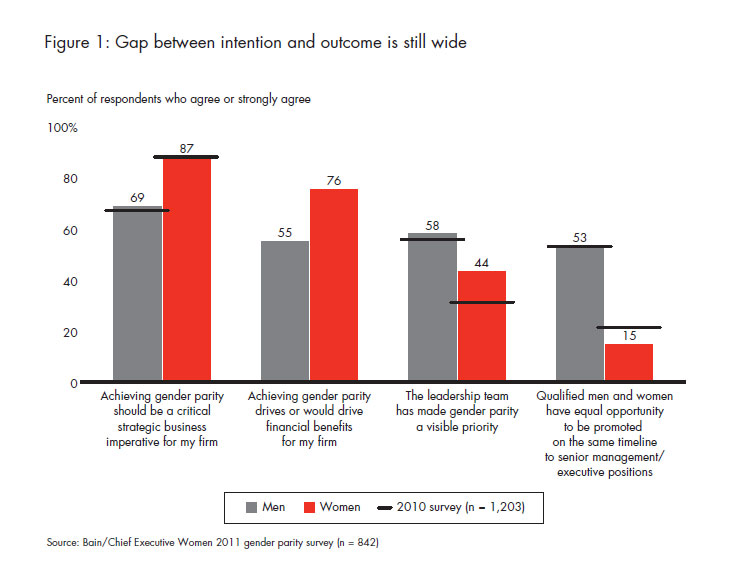
There are two factors that may explain the disappointing lack of progress. First, there is a meaningful segment of the business community that is not yet convinced of the business case for change. Although 76 per cent of the women in the study believe that gender parity can result in financial benefits for their organisations, only 55 per cent of the men agree. That suggests the business case for diversity is still not well understood or accepted. Until that happens, achieving gender parity remains a moral imperative rather than a financial one.
Second, implementing change is difficult. It requires shifting underlying beliefs and behaviours. The brutal fact is that the barriers to women’s progression into leadership roles are in large part due to perceptions of a woman’s ability to lead. These beliefs appear to be linked to differences in style. Challenging these beliefs will require a cultural change over the long term.
The 2011 Bain and CEW survey reveals three specific key insights about what stops women from achieving leadership positions:
- Two big issues hold women back: perception about the challenges associated with competing work-life priorities and the fact that women’s style is different from men’s—and not as valued;
- Women and men both acknowledge they have different styles, but most men don’t consciously recognise the obstacles that presents for a woman’s “promotability”;
- The underlying views about women’s style affect perceptions of their ability to lead.
Dealing with these issues will require strong, committed leadership and sustained action over the long term to create an environment that values and promotes a spectrum of styles, as well as flexible working options.
Two schools of thought around why women are not progressing
Respondents agree on the key factors that stop women from reaching the top. However, two distinct schools of thought emerge when respondents are grouped based on the issues they feel are the most significant. One group believes the dominant reason for women’s lack of progress can be attributed to competing priorities (41 per cent of respondents). The second group believes differences in style (59 per cent of respondents) are the critical inhibitor.
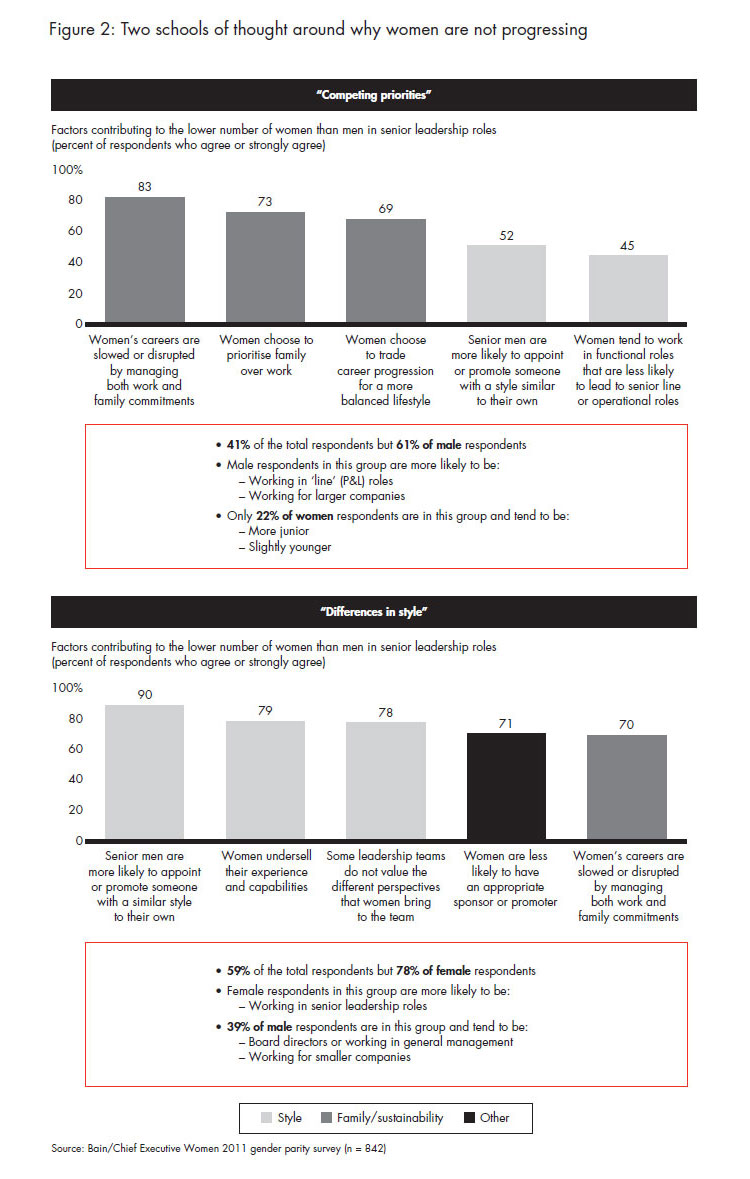
Competing priorities
Those who believe that women’s “competing priorities” limit their progress feel strongly that women fail to reach leadership positions primarily because of the challenges associated with juggling work and family, or because women choose to prioritise a more balanced lifestyle (see Figure 2). These respondents listed the following factors as the most important inhibitors of women’s advancement to leadership positions:
- Women’s careers are slowed or disrupted by managing both work and family commitments (83 per cent agreed or strongly agreed);
- Women choose to prioritise family over work (73 per cent agreed or strongly agreed);
- Women choose a more balanced lifestyle over career progression (69 per cent agreed or strongly agreed).
The majority of men (61 per cent) are in this group that feels competing priorities limit women (see Figure 3), and these men are predominantly in line roles. They look at the lack of women’s progress and attribute it to their female colleagues having multiple and confl icting priorities between work and family. In contrast, only 22 per cent of women agree. That raises a question: Are men making valid assumptions about their female colleagues’ priorities and aspirations? In the words of one female respondent:
“[There is a] lack of understanding in upper echelons of the organisation...Impediments to promotion include [feedback to a] single mother of two who delivers projects on time and to the highest standard that ‘she could undoubtedly do the job but it might not be the right time in her personal life’ to receive a significant promotion. Need I say much more?”
The 22 per cent of female respondents who do believe that competing priorities is the main inhibitor to progress tend to be more junior and slightly younger. These women are most likely to be weighing up the challenges associated with staying on a career track and having a family. The juggling act of career and family can seem very tough, especially if the organisational environment is not conducive to achieving that balance. It raises the onus for organisations to demonstrate that flexible career paths are viable for all employees or face a potential exodus of their future female and male talent from their workplace.
Differences in style
Those who believe that “differences in style” limit a woman’s progression say that women are held back because they are different (see Figure 2). These respondents list the following factors as the most important inhibitors of women’s advancement to leadership positions:
- Men in senior roles are more likely to appoint or promote someone with a style similar to their own as the top factor (90 per cent agree or strongly agree);
- Women undersell their experience and capabilities (79 per cent agree or strongly agree);
- Some leadership teams do not value the different perspectives that women bring to the team (78 per cent agree or strongly agree).
Seventy-eight per cent of women in the study are in this group, and they tend to be more senior women. They see the same lack of progress for women but view the underlying issues very differently. They believe the shortage of women executives is explained by different styles and lack of appreciation for those differences by those who might promote them. The 39 per cent of men who agree with them tend to be board directors, general managers or work in smaller companies. These men are likely to be those that have greater visibility or awareness of the consequences of different styles on women’s progression.
One woman articulates the challenges of different styles:
“[Senior leaders] do not seem to understand the value of having different styles and experiences in their management team in order to provide a more balanced perspective and to challenge the thinking of the ‘mob’.”
The story appears to be a simple one. It is human nature for like to seek like. The vast majority of senior promotion decisions are made by men, who are more likely to seek people more like themselves than not. Women don’t typically fit the bill—they work differently, behave differently and are less comfortable promoting their ability.
A respondent sums up the issue this way:
“Australia has deeply entrenched and outmoded social attitudes and norms around gender roles at home and work. The concept of ‘mateship’ is too often abused as a proxy for [or to legitimise] the exclusion of women by men—and I say this as a man.”
The research crystallises two key issues facing the Australian business community with respect to helping women reach their full potential. We need widespread acceptance and implementation of different ways of working to help women and men effectively manage career-life transitions. And we need to create organisational environments where a spectrum of styles is valued, embraced and celebrated.
The starting point for these two issues is vastly different. Although we still have a long way to go to make flexible career paths a genuine and accepted option, there is at least broad acknowledgement of the issue and a number of proven examples that organisations can use as models or case studies. However, the issues of style and gender biases are much more challenging to confront and resolve. Equally, the solutions are unlikely to be straightforward or easy to implement.
One telling fact is that the women who believe women’s styles are not as valued as men’s are much less likely to recommend their organisation as a place for other females to work; they gave their organisations an average NPS of negative two per cent (see Figure 3). In contrast, the 22 per cent of women who believe style is not the primary problem have a much higher level of advocacy for their companies, giving an average NPS of 28 per cent. That suggests that those who identify the style issue as most relevant recognise the challenges associated with the necessary cultural change and are questioning the prospects of that journey ever really unfolding.
To understand how different styles hold women back, we explored why style is so important and what its impact might be on women’s career progression. Is it true that women have different styles? What are those styles, and what are the consequences of different styles when promotion opportunities arise?
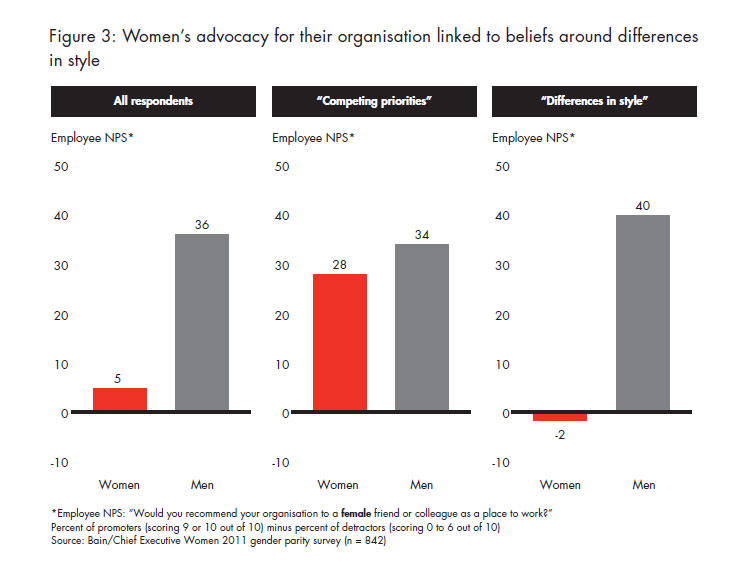
Women and men acknowledge they have different styles, but men don’t see the impact on women’s opportunities for advancement
Women and men are viewed as equally effective at delivering outcomes for their organization. There is no gender difference in attributes such as making commercially sound decisions, managing high-pressure situations and delivering significant or transformative change. More important, these are the critical attributes that create value and drive results in organisations (see Figure 4).
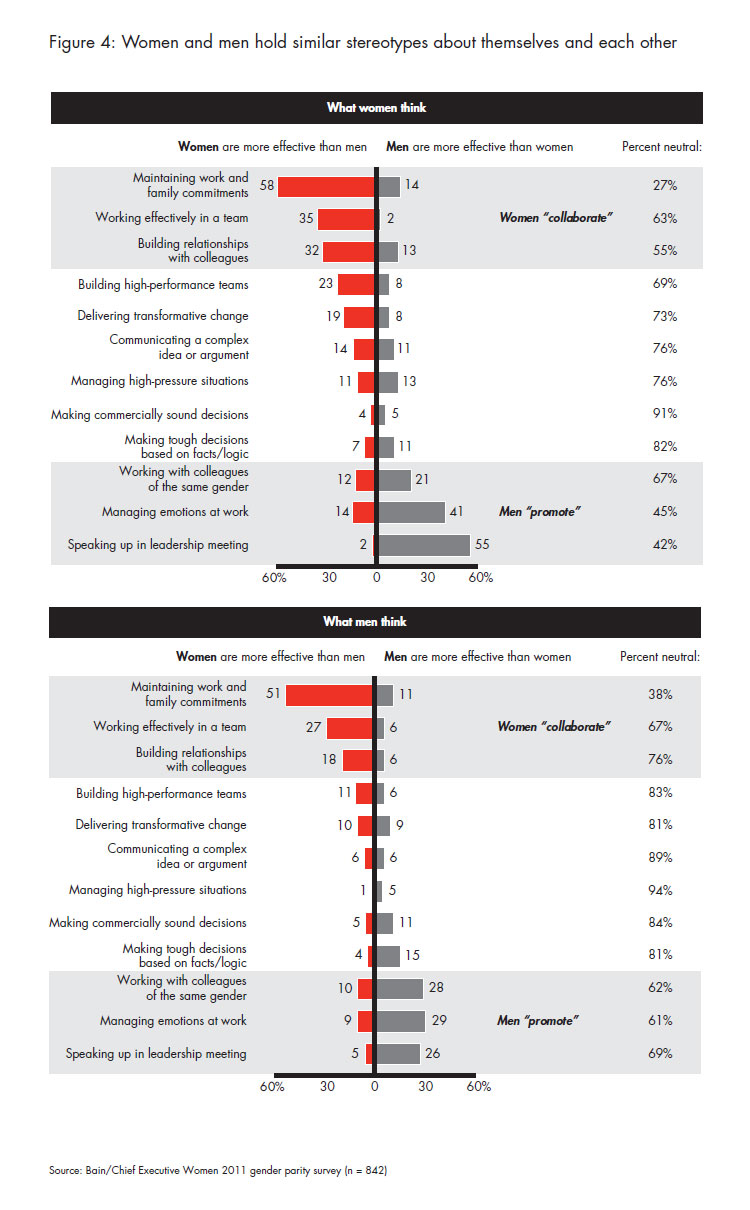
However, men and women agree that they achieve these outcomes with quite different styles. Simply put, women collaborate more and men promote their points of view more effectively.
Both women and men tend to agree that women are more effective at building teams and relationships with colleagues as well as at balancing family commitments. For example, on the dimension of working effectively in a team, about one-third of women and men agree that women are more effective at it.
Both also tend to agree that men are more effective at speaking up at meetings and managing their emotions at work. Fifty-five per cent of women believe men are more effective at speaking up in leadership meetings, whilst only 5 per cent of men are likely to see a woman being more effective at it.
Men and women do agree that they have different styles, but they have very different views of the relative impact of style on each other’s careers. Men do not see differences in style as an issue that holds women back professionally. Women feel that differences in style negatively impact their progression an average of seven times more often than men’s career progression. However, men tend not to recognise that having a different style is something that uniquely affects women. Men believe style affects both genders with similar frequency and, in fact, say they are twice as likely as women to be overlooked for a promotion because of differences in their leadership or interpersonal styles (see Figure 5).
However, men readily acknowledge the negative career consequences for women with competing family priorities and agree that it affects women more frequently than it does men, by two to four times. Women agree wholeheartedly with that. They believe that either a real or perceived lack of flexibility and commitment on their part is 13 times more likely to affect their careers, and that having their role “de-scoped” while on parental leave happens 20 times more often to women.
That both women and men regard the differences in style as career inhibitors for their respective genders highlights a much deeper issue around how diversity of all types is valued in organisations. Clearly, neither women nor men feel that style differences by either gender are embraced by their organisations.
Women do feel, however, that a lack of acceptance of various styles differentially affects them. Men don’t agree, which highlights a lack of shared understanding about the challenges facing women aspiring to leadership. That apparent gap in perceptions underlines the difficulty in getting organisations to acknowledge and tackle the complex topic of valuing diverse leadership styles.
Even though women are deemed to be as capable as men at delivering outcomes, the reality is that a woman’s approach to achieving these outcomes is less likely to be valued. If women approach their work with a different style from most men, and if men in leadership prefer working with others whose style is similar to their own, it becomes challenging for a woman to convince her superior that she is the right person for the promotion. That is the heart of gender bias and makes it difficult for true meritocracy to exist. Even with a strong, acknowledged business case for diversity, women find it tough to break through these issues on their own.
To better understand how differences in style influence perceptions of leadership capability, we asked survey respondents to evaluate their own leadership effectiveness, as well as that of their female and male colleagues.
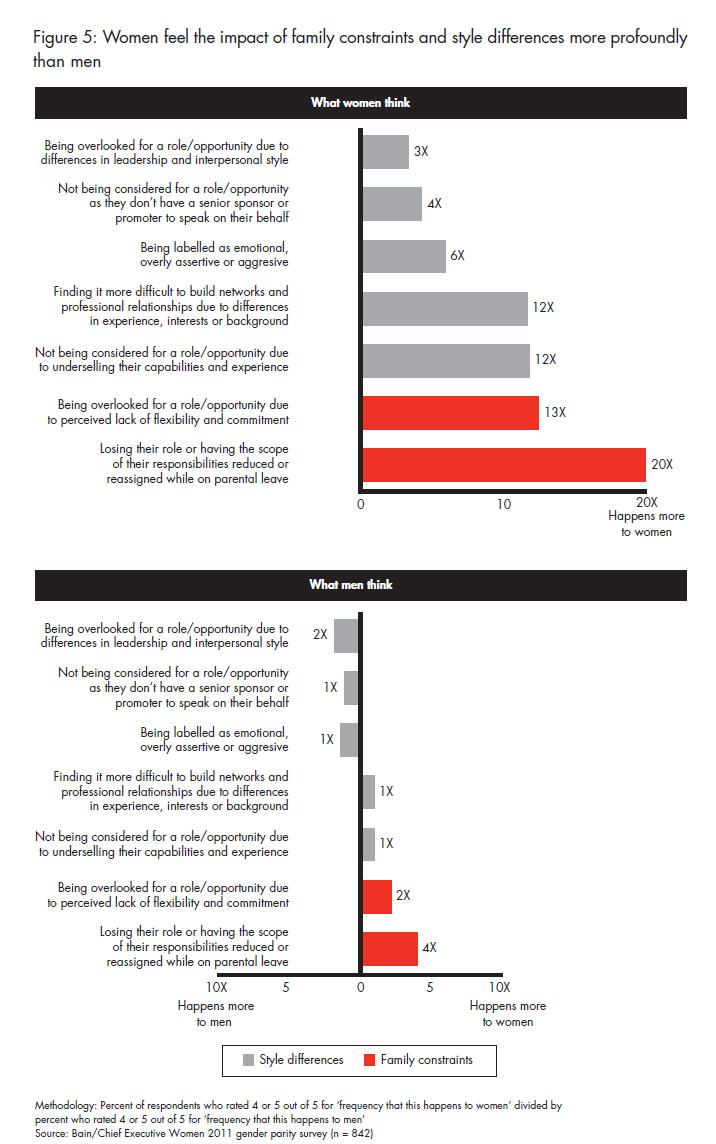
The underlying views about women’s style affect perceptions of their ability to lead
Our research shows that women are perceived to be less effective at the leadership attributes that are most emphasised and rewarded by organisations. That sheds some light on why women feel they do not have equal opportunity— the stark fact is women’s collaborating style is not perceived to be as effective as men’s promoting style.
Applying a research approach used by Catalyst9, we asked respondents to rank the 10 leadership attributes in the order that their organisations emphasise and reward. Men and women clearly agree that the four highest ranking attributes of leadership are problem solving, influencing, team building and networking (see Figure 6).
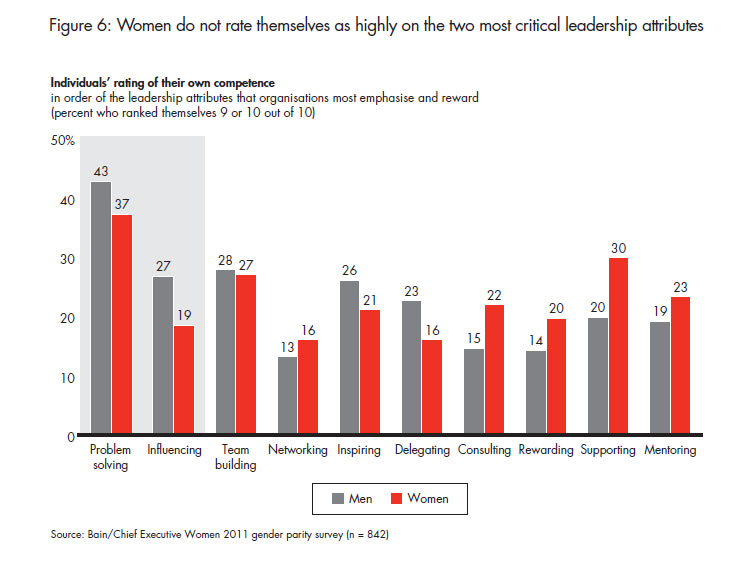
When ranking themselves on the same leadership attributes, women confirm one of the most worrying aspects of their style. Women undersell their capabilities, even though they are deemed to be equally as effective as men at delivering value for their organisations. For the top two leadership attributes—problem solving and influencing—women are 16 per cent and 40 per cent, respectively, less likely to rate themselves as being as highly competent as men, raising an important question: Do women really perceive themselves as less competent, or do they simply feel they are unable to be as effective because their style is not as valued by the majority of their peers as men’s? We suspect the latter.
Even worse, men completely agree with women (see Figure 7). Men are twice as likely to rank other men over women as being highly effective problem solvers. It is also interesting that women also rank other women as less effective problem solvers. Is it because women are truly not as good at problem solving or because the term “problem solving” is deemed to be more characteristic of a masculine promoting style?
It is puzzling that women rate poorly on problem solving when men and women are believed to be equally capable at delivering outcomes. We suspect that women approach problem solving in a different way, through collaborating and teaming, which is less likely to garner individual recognition and acceptance.
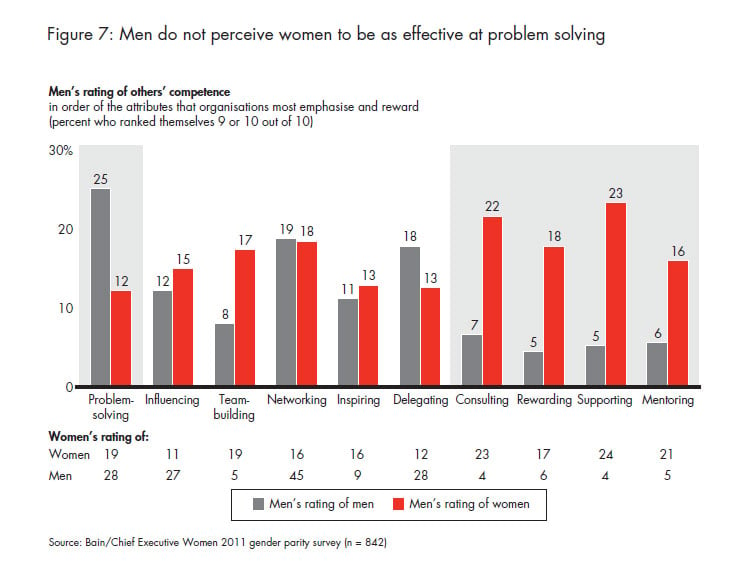
In contrast, women are viewed as being stronger in the high emotional quotient (EQ) skills, such as consulting, rewarding, supporting and mentoring, by both men and women, but these are the leadership attributes that tend to be less overtly recognised and rewarded by organisations.
The bottom line is clear: Men and women are different, but both deliver on the job and make strong leaders. In fact, the balance created by men and women working together is powerful. How can we create an environment in corporate Australia that acknowledges and removes the unintended bias embedded in the recruitment, promotion and appointment processes, and actively seeks to build cultures that celebrate different leadership styles?
What can be done to tackle the tough issues?
The call to action is clear: We must create environments that embrace a spectrum of styles and working models. Without that, organisations will continue to lose potential and existing female leaders from their talent pipelines and miss the opportunity to reap the rewards of having a diverse leadership team.
It will require organisations to value and promote diversity in their executive teams. It will also require widespread acceptance and implementation of flexible career paths to help women manage critical life events effectively, whilst still moving ahead in their careers. However, none of this will be possible without sustained and visible leadership commitment and cultural change, starting with the Board and CEO. To understand if your organisation is tackling the tough issues, consider your responses to the “acid test” questions outlined (see below “Acid test questions for the Board, CEO and senior executives”).
-
Demonstrate visible leadership over the long term. Creating a culture that embraces diversity and practices career flexibility must be led from the top (see Figure 8). The confronting nature of these issues and the organisational maturity needed to address them requires the CEO to lead from the front. Only then can the issue of gender bias be openly discussed and the consequences understood. Signaling top-down commitment to diverse teams can take many forms, such as setting and communicating measurable diversity targets and appointing strong women to senior roles where appropriate.
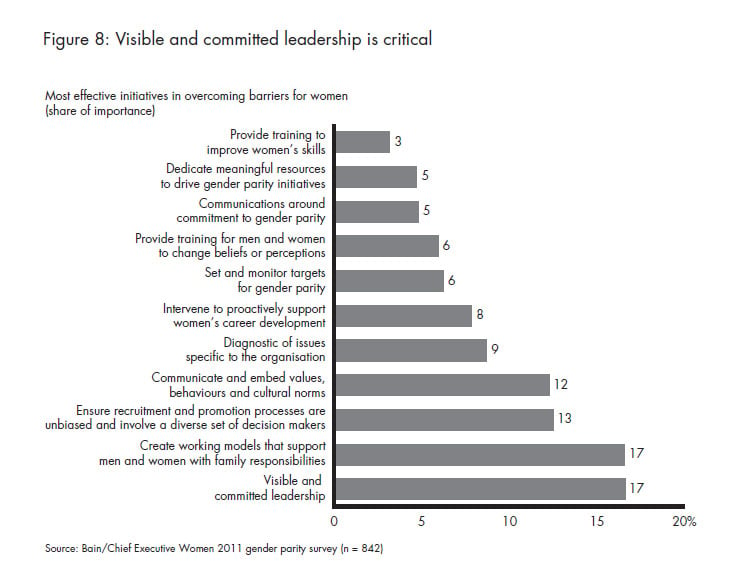
-
Raise awareness and build understanding. It is clear that men and women have differing views on the issues. For organisations that are just beginning to tackle this issue, the journey should start with raising awareness and creating a common understanding of the importance of diversity and both the practical and the cultural issues which must be tackled. Awareness alone will not be enough to solve these problems, but it is a necessary first step. Having the courage to surface and sensitively navigate the topic of style differences is a part of this process. If the existence of gender bias is not widely understood, it can be addressed by undertaking a diagnostic to understand how leadership ability is defined within the organisation and how that definition may create both conscious and unconscious biases.
Cultural change can be initiated through a process of education, communication and training. This could include educating employees about the business case for diversity, helping them recognise stereotyping and showcasing successes of women leaders, especially their ability to be successful with a range of styles. In addition, leadership training needs to allow both women and men to develop techniques to “flex” their style in order to improve their leadership effectiveness in a range of contexts.
-
Define what great leadership looks like and how you can strengthen diversity at the top. Having a clear and gender neutral definition of what good leadership looks like is important. It creates a common frame of reference and a common language for talking about the repertoire of leadership attributes that are required in an effective executive team. A clear definition also allows organisations to acknowledge that styles differ and creates the opportunity to have an open dialogue about genuine strengths and weaknesses of various leadership candidates. That is a necessary screen to ensure promotions are not open to bias.
Defining the model for good leadership can be powerful. It enables chairs and CEOs to evaluate the collective strengths and weaknesses across the talent pipeline and in executive teams, and to identify where opportunities exist to increase leadership diversity and raise the quality of collective decision making.
-
Seek to remove structural biases and make promotions more meritocratic. Once a clear definition of good leadership is in place, CEOs should initiate systematic reviews of promotion and succession practices to ensure that they are not tainted by bias of any sort, including gender bias. This involves ensuring that there are objective criteria and unbiased evaluation and decision-making processes. For example, organisations could remove gender bias in the evaluation of candidates for promotion by ensuring that there is diversity in the decision makers; the leadership attributes and assessment criteria are objective and explicit; and there is a requirement to field a diverse range of candidates.
A case study from the public sector demonstrates the value of implementing those practices. For more than 20 years, Jennifer Westacott, now executive director of the Business Council of Australia, was a public servant in Victoria and NSW. For a considerable part of that time she held the chief executive and other senior roles. She observed that “there are some important ingredients that have contributed to the success of the public service in promoting women into leadership positions. At their core, the reforms were aimed at achieving a more capable, more responsive public sector. Some very simple steps were taken, principally around removing the structural biases in selection and recruitment processes. Selection committees were compelled to document how each candidate met the competencies, skills and criteria articulated for a particular position. This was done through a formal written application, an interview, assessment of a candidate’s proven experience, and structured referee feedback against the requirements of a position.”
Did it work? Jennifer notes that “while there is a long way to go, by clearly articulating the competencies required for leadership roles and evaluating people against those criteria to ensure ‘merit selection’, the public service is addressing diversity in leadership positions.”
-
Make flexible models an accepted part of the mainstream. Previous Bain research has clearly shown that flexible ways of working are in high demand by both women and men—more than 75 per cent of the respondents were interested in having workplace flexibility.10 Flexibility is also proven to lead to significantly improved employee advocacy, if implemented successfully.
However, offering flexible work options is not enough. Employees have to see these models working, particularly for those identified as current or future leaders. Despite the high interest shown in flexible work options, relatively few employees choose these options for fear that they will signal a career “dead end”. Until these working arrangements become a more accepted and mainstream feature of working life, organisations will “leak” both male and female talent seeking other ways to manage tough periods, when they have competing career-life demands.
Flexible ways of working does not just mean part-time career options at various stages in a career. It can mean allowing flexible start times, finish times and the option to work from home at times. Allowing the job to accommodate changing life demands can be a significant differentiator for companies seeking to attract male and female talent.
That requires CEOs to create and communicate real proof points that flexible working models are viable and getting the job done well is the priority, not having face time in the office. It also means ensuring that part-time employees are set up for success with meaningful and manageable roles, with the right level of sponsorship and support, and by communicating the success stories widely across the organisation.
Tackling these issues is tough. It requires shifting underlying beliefs and behaviours, which takes strong, committed leadership and sustained action over the long term. However, if CEOs can foster environments that value and promote a spectrum of styles and working models, realising the leadership potential from our female talent will have a better chance of success.
Melanie Sanders is a partner with Bain & Company. She leads Bain’s Asia- Pacific Customer Strategy & Marketing practice and the Asia-Pacific Women at Bain program.
Jayne Hrdlicka is a member of Chief Executive Women, a group executive at Qantas, nonexecutive director of Woolworths and a former partner with Bain & Company.
Meredith Hellicar is a member of Chief Executive Women and principal of Merryck & Company. She has held a range of CEO roles and chaired Australian public and private companies, international boards and committees.
Dale Cottrell is the managing partner of Bain & Company’s Australia practice. Joanna Knox is a manager with Bain & Company and is a local leader of Women at Bain programs.
Bain & Company and Chief Executive Women would like to acknowledge Ergo (ergostrategy.com.au) for its support in the survey design and analysis, and Research Now for its fieldwork and for hosting the survey.
What is Net Promoter score?
The Net Promoter® score (NPS®) is a measure of customer and employee advocacy. Research conducted by Bain & Company shows that the question, “How likely are you to recommend this company to a friend or colleague?” is a reliable indicator of individual loyalty behaviours. Customers or employees are asked to score their company on the “would recommend” question using a scale of zero to 10. Those who give a nine or 10 are labelled “promoters”— they are the customers or employees who are likely to refer more, stay longer or buy more. Those who rate the company from zero to six are labelled “detractors“—these are the customers and employees who generate negative word of mouth and show higher defection rates. NPS is calculated by subtracting the percentage of detractors (liabilities) from the percentage of promoters (assets). Go to www.netpromotersystem.com for more about NPS.
Acid test questions for the Board, CEO and senior executives
Are you confronting the tough issues?
- Do we understand the commercial imperative for gender diversity in our own organisation?
- Can we define the specific attributes of what great leadership looks like for our organisation? Are they gender neutral?
- Do we understand where gender bias exists and have an action plan to address it?
- How have we ensured that our key people processes around compensation, development, selection and promotion are not open to bias?
- Is it the standard in our business that people can work flexibly?
- Do we have specific and measurable targets for women on the Board and executive team over a defined period?
- What 1–2 leadership actions can I personally take to demonstrate my commitment to diversity?
1 Although this quote is often attributed to Victor Hugo, it is only a rough translation of a similar sentiment expressed in his book Histoire d’un Crime. http://en.wikiquote.org/wiki/Victor_Hugo
2 Jayne Hrdlicka, Dale Cottrell and Melanie Sanders, “Level the playing field: A call for action on gender parity in Australia,” Bain Insights, September 22, 2010, www.bain.com/publications/articles/level-the-playing-field-a-call-for-action-on-gender-parity-in-australia.aspx.
3 “Appointments to ASX 200 Boards,” Australian Institute of Company Directors, accessed October 24, 2011. www.companydirectors.com.au/Director-Resource-Centre/Governance-and-Director-Issues/Board-Diversity/Statistics.
4 “EOWA 2010: Australian Census of Women in Leadership,” (Research conducted by Macquarie University, supported by ANZ), Australian Government Equal Opportunity for Women in the Workplace Agency, accessed October 26, 2011; www.eowa.gov.au/Australian_Women_In_Leadership_Census/2010_Australian_Women_In_Leadership_Census/Media_kit/EOWA_2010_Census_Full.pdf
5www.mapairports.com.au/; www.pacificbrands.com.au/; www.austarunited.com.au
6 Jayne Hrdlicka et al., “Level the playing field: A call for action on gender parity in Australia.”
7 The Net Promoter® score (NPS®) is a measure of customer loyalty. Bain & Company research established that one question reliably indicates customer loyalty (as evidenced both by repurchase behavior and referral rates) in most industries.) Customers who rated a company high on the “likely” scale bought more goods and services, bought them more often, gave the company a greater share of their wallet, and were more likely to talk up the company to others. For more information about the Net Promoter score, see Fred Reichheld and Rob Markey, “NPS: The next Six Sigma? The Net Promoter score for measuring customer loyalty is emerging as a favorite metric for managers seeking organic growth,” BusinessWeek Online, September 25, 2006, http://www.bain.com/publications/articles/nps-the-next-six-sigma-the-net-promoter-score.aspx
8 The 2011 Bain/CEW study included 842 respondents: 66 per cent were women and 34 per cent were men. 72 per cent were senior managers, 46 per cent worked for companies with more than 10,000 employees. The 2011 study asked some of the same questions as the 2010 Australia study and was administered online over a two week period in August 2011. We explored the “softer” more qualitative issues in two focus groups prior to launching the survey.
9 These attributes are described in a 2005 study by Catalyst, sponsored by General Motors. The Catalyst research identified the same top four leadership attributes the respondents in our study identified. For more information about the Catalyst study, see “Women ‘Take Care’, Men ‘Take Charge’: Stereotyping of US business leaders exposed”, Catalyst, October 2005, accessed October 24, 2011; www.catalyst.org/publication/94/women-take-caremen- take-charge-stereotyping-of-us-business-leaders-exposed.
- Problem solving: Identifying, analysing and acting decisively to remove impediments to work performance
- Influencing: Affecting the actions, behaviours or opinions of others
- Team building: Encouraging positive identification with the organisation unit, cooperation and constructive conflict resolution
- Networking: Developing and maintaining relationships with others who may provide information or support resources
- Inspiring: Motivating others towards greater enthusiasm for, and commitment to, work objects by appealing to emotion, value, or by personal example
- Delegating: Authorising others to have substantial responsibility and discretion
- Consulting: Checking with others before making plans or decisions that affect them
- Rewarding: Providing praise, recognition and financial remuneration when appropriate
- Supporting: Encouraging, assisting and providing resources for others
- Mentoring: Facilitating the skill development and career advancement of subordinates
10 Julie Coffman and Russ Hagey, “Flexible work models: How to bring sustainability to a 24/7 world,” Bain Insights, October 18, 2010; www.bain.com/publications/articles/flexible-work-models-how-to-bring-sustainability-to-24-7-world.aspx.







